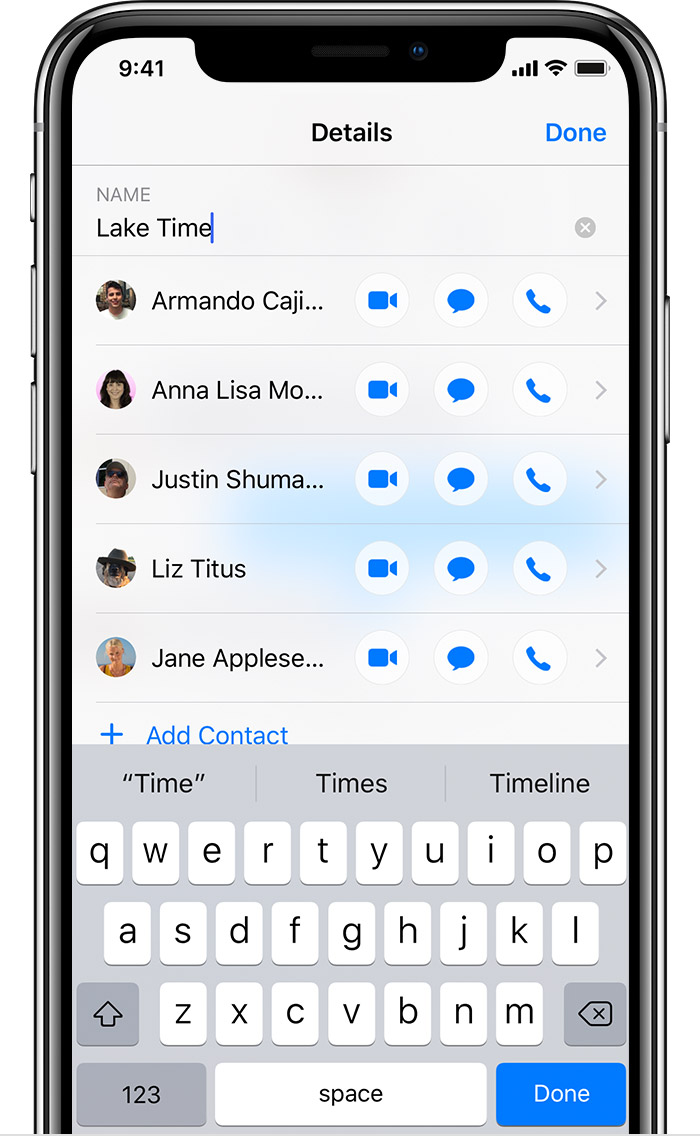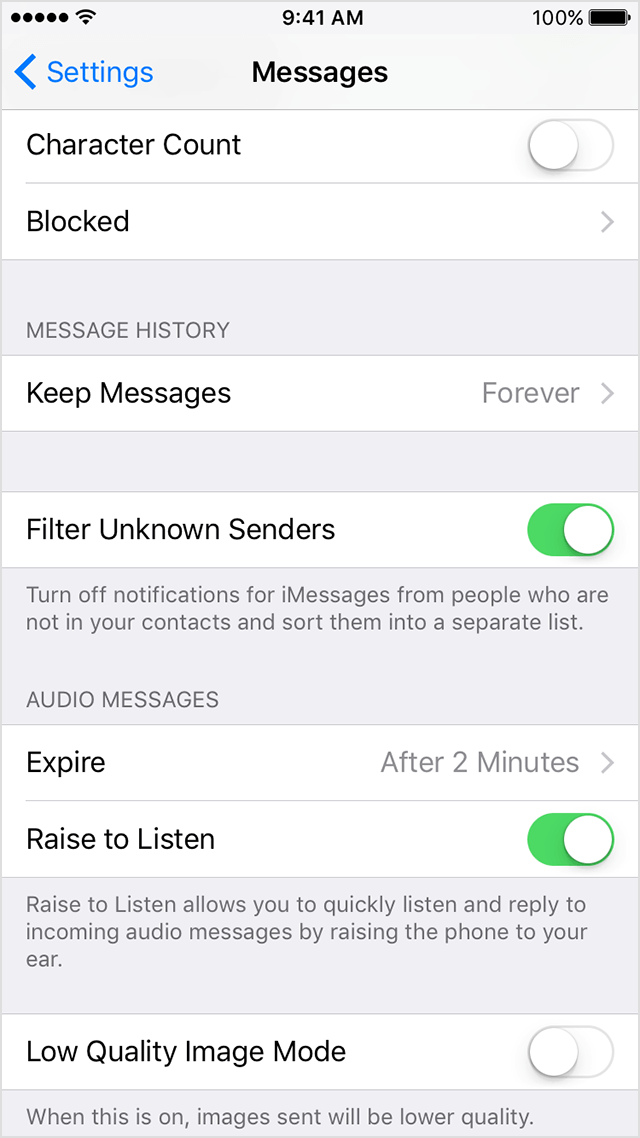Set up your phone number
On your iPhone:

- Go to Settings > Messages and make sure that iMessage is on. You might need to wait a moment for it to activate.
- Tap Send & Receive. If you see “Use your Apple ID for iMessage,” tap it and sign in with the same Apple ID that you use on your Mac, iPad, and iPod touch.
- In the 'You can receive iMessages' section, make sure that your phone number and Apple ID are selected.
- Go to Settings > FaceTime and make sure that your phone number and Apple ID are selected in the 'You can be reached by FaceTime at' section.
- I received a new iPod Touch, I created my Apple ID and an account on iTunes. When trying to log in to iMessage it cycles trying to connect and then simply stops. As an example, when I hit sign in it starts spinning and the sign in button grays out. After a few moments the button pops back up and it hasn't signed in.
- The main difference is the size of the screens. The iPod touch uses the same 4-inch.
On your other devices, you can now turn on the phone number that you just set up:

Apple-designed iMessage to be seamless across all your devices. This is why you can send and receive iMessages from your iPhone, iPad, iPod touch, and Mac. But what if you want to stop iMessage from going to your iPad or your Mac? What if you want to restrict iMessages to iPhone-only? Both FaceTime and iMessage use the Internet to connect with other Apple users, so you have to be connected to a Wi-Fi network on your iPod touch in order to set up either service. In this video, you will learn how to use iMessage.iMessage is a messaging service only for Apple Devices. It allows iPhone users to talk to other iPhone user.
If you use this feature and share your Apple ID with someone, you can't prevent them from seeing your conversations. Instead of using the same Apple ID as someone else, set up Family Sharing.
Remove your phone number
If you don't want calls or messages for your iPhone on your iPad, iPod touch, or Mac, you can remove your phone number. There are two ways to do this:
- On your iPhone, go to Settings > Messages > Send & Receive. Select your Apple ID at the bottom of the screen and tap Sign Out. Then go to Settings > FaceTime, select your Apple ID and tap Sign Out.
- If the phone number that you want to remove belongs to an iPhone that you can't access, change your Apple ID password. This removes all phone numbers from your iPad, iPod touch, and Mac. Calls or messages for the removed numbers won't appear on those devices anymore.
If you have questions, contact Apple Support.
Turn your phone number on or off for your Mac
After you set up your phone number, you can turn it on or off for Messages and FaceTime on your Mac.
- Open Messages or FaceTime. If asked, sign in with the Apple ID that you're using with Messages and FaceTime on your iPhone.
- For Messages, choose Messages > Preferences, then click iMessage. For FaceTime, choose FaceTime > Preferences, then click Settings.
- Turn your phone number on or off:
- To turn on your phone number, select it and your Apple ID in the list. If you don't see your phone number, get help with your settings or contact Apple Support. If you see a number that isn't yours, change your Apple ID password.
- To turn off your phone number, deselect it in the list.
- If you want recipients to see your phone number and not your Apple ID, select your phone number from the “Start new conversations from” or ”Start new calls from” pop-up menu.
Learn how to make messages that you send and receive on your iPhone appear on your Mac, iPad, and iPod touch.
Turn your phone number on or off for your iPad or iPod touch
After you set up your phone number, you can turn it on or off for Messages and FaceTime on your iPad or iPod touch.
- For Messages, go to Settings > Messages and make sure that iMessage is on. If asked, sign in with the Apple ID you're using with Messages and FaceTime on your iPhone. Then tap Send & Receive.
- For FaceTime, go to Settings > FaceTime. If asked, sign in with the Apple ID that you're using with Messages and FaceTime on your iPhone.
- Turn your phone number on or off:
- To turn on your phone number, select it and your Apple ID in the “You can be reached” section. If you don't see your phone number, get help with your settings or contact Apple Support. If you see a number that isn't yours, change your Apple ID password.
- To turn off your phone number, uncheck it.
Learn how to make messages that you send and receive on your iPhone also appear on your Mac, iPad, and iPod touch.
If you can't see or select your number in Messages or FaceTime

- Make sure that you're using the latest software for your Mac or iOS device.
- Make sure that you correctly followed the iPhone steps to set up your phone number. You should be using the same Apple ID on all of your devices.
- In the “You can be reached” section of Messages and FaceTime settings, make sure that there are checkmarks beside your phone number and Apple ID:
If your phone number is unchecked and you can't select it, or you have some other issue, follow these steps:
- On your Mac:
- In Messages, choose Messages > Preferences, then click iMessage. Click Sign Out.
- In FaceTime, choose FaceTime > Preferences, then click Sign Out.
- On your iPhone, iPad, and iPod:
- Go to Settings > Messages > Send & Receive. Tap your Apple ID, then tap Sign Out.
- Go to Settings > FaceTime. Tap your Apple ID, then tap Sign Out.
- On your iPhone:
- Go back to Settings > Messages and make sure that iMessage is turned on.
- Tap Send & Receive, then choose “Use your Apple ID for iMessage” and sign in with your Apple ID.
- Using the same Apple ID, sign back in to Messages and FaceTime on your other devices.
If you still need help, change your Apple ID password and repeat the setup steps. If that doesn't work, contact Apple Support.
When you’re in a group message with one of your Android-using friends, those green bubbles can be annoying. And not only are they ugly, but they also limit interactions, don’t play nicely with Messages on the Mac, and can have issues with delivering. But for those of us who have been holding out for an Android app that brings the iMessages experience across enemy lines, it’s likely to be a very, very long wait.
In a “proposed findings of fact and conclusion of law” filing by Epic Games in its suit against Apple over the terms of the App Store, Epic revealed that Apple once considered a version of iMessage for Android but decided against it “as early as 2013,” just two years after it launched on iOS. Using information gleaned from depositions with senior Vice President Eddie Cue, along with comments from Apple fellow Phil Schiller and senior vice president Craig Federighi, Epic claims that Apple’s ultimately decided that the iMessage’s “serious lock-in” was more valuable to the company than cross-platform convenience.
b. Mr. Cue testified that Apple “could have made a version on Android that worked with iOS” such that there would “have been cross-compatibility with the iOS platform so that users of both platforms would have been able to exchange messages with one another seamlessly”.
c. However, Craig Federighi, Apple’s Senior Vice President of Software Engineering and the executive in charge of iOS, feared that “iMessage on Android would simply serve to remove [an] obstacle to iPhone families giving their kids Android phones”.
d. Phil Schiller, an Apple executive in charge of the App Store, agreed that Apple should not offer iMessage on Android devices.
e. In 2016, when a former Apple employee commented that “the #1 most difficult [reason] to leave the Apple universe app is iMessage . . . iMessage amounts to serious lock-in” to the Apple ecosystem, Mr. Schiller commented that “moving iMessage to Android will hurt us more than help us, this email illustrates why”.
Cue also added that “one of the results of the Apple ecosystem [is that products such as iMessage] don’t work seamlessly with devices written for other OSes,” according to the filing. Additionally, Federighi testifies that it would be “a horrible idea” to make it easier for someone to switch to another platform by eliminating all of the iPhone’s differentiation.
Epic uses the iMessage stance (along with Find My and Continuity) to show how Apple pursues a system that continues to lock customers into its ecosystem, “even when its conduct results in higher consumer prices.” The company’s lawyers point to the 2012 eBook lawsuit that found Apple guilty of conspiring to fix eBook prices in order to compete with Amazon.
Ipod Touch Imessage
Epic concludes that Apple consciously makes switching to a new platform purposefully complex, expensive, and frustrating. Consequently, Epic argues, mobile app developers “cannot afford to forgo distributing their apps to iOS users, as doing so would entail giving up access to approximately one billion potential customers, who form the most lucrative part of the available customer base.” That gives Apple “enormous bargaining power over developers” and “makes developers heavily dependent on Apple.”
Ipod Touch Imessage Activation
Of course, none of this should be a surprise to anyone who has used an Apple device in the last ten years. And it’s not all that different over on Android. But it does shine a light on just how much control Apple has over the user experience and how much it’s dependent on ecosystem lock-in. It’s not just about creating a seamless and simple system for its users so they want to stay, but also making it very hard to leave even if they want to.
